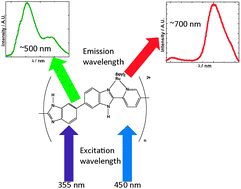Ground and excited state communication within a ruthenium containing benzimidazole metallopolymer†
Abstract
Emission

* Corresponding authors
a
Centre for Forensic Science, Department of Pure & Applied Chemistry, University of Strathclyde, Royal College, 204 George Street, Glasgow, Scotland, UK
E-mail:
lynn.dennany@strath.ac.uk
Fax: +141 548 2532
Tel: +141 548 4322
b
National Centre for Sensor Research, School of Chemical Sciences, Dublin City University, Dublin 9, Ireland
E-mail:
Robert.Forster@dcu.ie
Fax: +353 1 7005503
Tel: +353 1 7005943
Emission

 Please wait while we load your content...
Something went wrong. Try again?
Please wait while we load your content...
Something went wrong. Try again?
E. J. O'Reilly, L. Dennany, D. Griffith, F. Moser, T. E. Keyes and R. J. Forster, Phys. Chem. Chem. Phys., 2011, 13, 7095 DOI: 10.1039/C0CP02638G
To request permission to reproduce material from this article, please go to the Copyright Clearance Center request page.
If you are an author contributing to an RSC publication, you do not need to request permission provided correct acknowledgement is given.
If you are the author of this article, you do not need to request permission to reproduce figures and diagrams provided correct acknowledgement is given. If you want to reproduce the whole article in a third-party publication (excluding your thesis/dissertation for which permission is not required) please go to the Copyright Clearance Center request page.
Read more about how to correctly acknowledge RSC content.
 Fetching data from CrossRef.
Fetching data from CrossRef.
This may take some time to load.
Loading related content
